#a novelization of the Bible with animal narrators added which is not the history of the world girl!
Explore tagged Tumblr posts
Text
Literally so exhausted from today and having family for thanksgiving
My one cousin’s kids are completely out of control, luckily my other cousin’s are better, although still young kids and the five of them together in my house is giving me (and my dad and sister and mom even though she won’t admit it) a huge headache. Like yes they’re family but I wish they’d respect that this is our house and there are rules and not to leave mountains of their things in every room. (Also my poor cats are terrified)
Also a day of walking a historical site with 5 kids including 4 under 7 years old is a lot.
#also both my cousins are rich like super rich not well off and the one cousin who’s kids are out of control is such a permissive parent#(prob because her husband hardly helps)#anyway she nevers says no to her kids and anytime they go to a store with their kids they get whatever they want like dropping $100s of#dollars on a simple trip to the craft store that was suppose to be for one thing#like yesterday we went to build a bear and she let each kid make 3 (3 each!) bears and it was so embarrassing because we held up a ton of#other customers because we literally had 10 bears instead of like 5 (one child only got two)#like how do you spend $500 on buildabear for 3 children plus two adults??#and literally every trip to a store is like this#over the summer my mom took them to a toy shop and said I’m buying you one thing each for your birthdays and these kids could literally not#compute that they could only get one thing so my cousin had to get each of them multiple stuff in addition#they are going to be so spoiled#plus they’re being raised super conservative catholic and basically only interact with my cousin’s husband’s catholic family on#a day to day basis#I asked the ten yr old what she was reading and she said a series about the history of the world and then I looked it up and it’s literally#a novelization of the Bible with animal narrators added which is not the history of the world girl!#I’m literally so afraid for them lol
2 notes
·
View notes
Photo
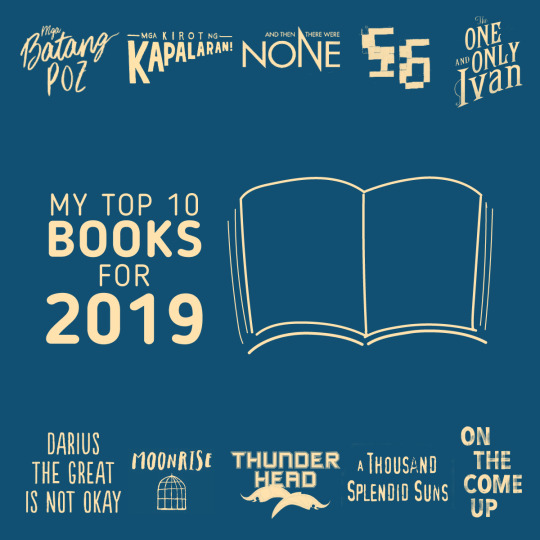
Twenty-eight books read in 2019. Sixteen longlisted books. One person who wastes his time writing sh*t as if they really matter.
Here it is. The best books I read in the past year.
HONORABLE MENTIONS
The unfortunate books that I had to let go since I only had ten spots to fill.
Turtles All the Way Down by John Green (2017)
Murder on the Orient Express by Agatha Christie (1934)
History Is All You Left Me by Adam Silvera (2017)
The Murder of Roger Ackroyd by Agatha Christie (1926)
Bird by Bird by Anne Lammott (1994)
The Silkworm by Robert Galbraith (2014)
*Ratings range from 1 to 5, with 5 being the highest
━━━━ ☆ ━━━━
10th Place
56 by Bob Ong (2018)
Rating: 4.300
Bob Ong makes a comeback on my list with his latest novel. His other book, Si, ranked 10th last 2015. This is the second time a Filipino book enters the list and is also the second nonfiction book ever—after Into the Wild last 2016.
In his latest release, Ong returns to the writing style that made him famous— reminiscent of his earlier books like ABNKKBSNPLAko. 56 is like a 300-page commentary or editorial about the issues of the present Filipino generation.
Other readers have found the book a little too preachy. I find it enlightening as it serves as a wake-up call to the Filipinos who are turning their blindsides to the harsh realities of our nation.
━━━━ ☆ ━━━━
9th Place
Mga Kirot ng Kapalaran (Kikomachine Komix blg. 11) by Manix Abrera (2015)
Rating: 4.445
This is a long-overdue recognition to my favorite comic strip artist (Fun Fact: I met him quite a few times already). For many years, I've ignored the chance to even put his works in the list of contenders. I'm not throwing it away again. Now, I have my first book to enter the top 10 classified under comics and graphic novels.
In this collection of strips by Manix Abrera, his work remains as humorous and as satirically laughable as the first time I saw his comic. Themes have changed to reflect the new trends and issues of our present society.
For as long as Manix draws and publishes his work, I will continue to read them as I know he gives an intellectual yet amusing input to our society's problems.
━━━━ ☆ ━━━━
8th Place
Mga Batang Poz by Segundo Matias, Jr. (2018)
Rating: 4.450
“Beautiful and relevant, but not flawless,” this is what I said on my review for this YA novel.
Mga Batang Poz is the third Filipino book on this list. Having three books on the list is a first. Furthermore, this is also the first time in four years that a Filipino book enters the list.
As previously mentioned, I have certain problems with regard to the overarching narrative of the novel. I wish that Matias could’ve written something more elaborate or something that doesn’t feel forced.
Nevertheless, the book accomplishes its goal of being a story that advocates HIV awareness, especially towards the youth.
━━━━ ☆ ━━━━
7th Place
The One and Only Ivan by Katherine Applegate (2012)
Rating: 4.485
In this book, you'll see both the cruelty and the compassion of humanity through the eyes of a gorilla named Ivan who is the narrator of the story.
Ivan is based on a real-life gorilla who was being used as a live animal attraction in Zoo Atlanta.
It is quite obvious that the book is meant for a younger audience, but despite this, I know anyone of any age will be able to appreciate it. Ivan is a gorilla after all, and I think the simplicity of how it was written suits his character, making the tone of the story more natural.
Overall, it was very touching. Although it mirrors pretty much what happened to the real-life Ivan, it efficiently delivers its message for animal welfare.
━━━━ ☆ ━━━━
6th Place
And Then There Were None by Agatha Christie (1939)
Rating: 4.525
This is a mystery novel filled with suspense and everything that'll make you love and hate it at the same time. The horror it gives chills you to the bone for every page you turn.
Agatha Christie is insane—and I mean that in a good way. The plot was so well-thought out that even when nearing at the end, I had no clue who the culprit was. When it was revealed to me, I was like, “Yeah. That makes absolute f*cking sense.”
For a book that has ten major characters, it does well in handling them. You know when a piece of literature is brilliantly made when even if its length isn’t considerably long, it doesn’t sacrifice the characters’ backgrounds and the narrative of the story.
Despite the novel’s inhumane and despicable acts, it also addresses issues about criminal injustices that are still prevalent today. In our country alone, criminals—corrupt officials, master drug dealers, rapists, murderers—are still roaming around the streets, evading the consequences of their actions. At times when the law is not enforced properly, people resort to their own type of justice.
━━━━ ☆ ━━━━
5th Place
Darius the Great Is Not Okay by Adib Khorram (2018)
Rating: 4.590
In this debut novel by Adib Khorram, the titular character Darius suffers from clinical depression. Also, he's a Star Trek and Lord of the Rings fan.
This book demonstrates the fact that real depression is not simply cured by positive reinforcement and bible verses—as what most overly religious people think.
The novel highlights Darius' relationship with the other characters—most especially with Sohrab. It shows how he copes up with them while he struggles with his mental disorder.
There are also subtle hints of homosexuality, which added to the overall tension of the story since the main characters are Muslims. It wasn't blatant but it was obviously present—in the right and necessary amount.
To me, this is a spiritual brother of Aristotle and Dante Discover the Secrets of the Universe by Benjamin Alire Sáenz—one of my favorite books. It gave me the same feeling of awe, beautiful pain, and joyful nostalgia. There were parts that broke my heart—I was ugly crying while riding a bus—and by the end, I was a complete mess, although I'm utterly happy.
━━━━ ☆ ━━━━
4th Place
Moonrise by Sarah Crossan (2017)
Rating: 4.595
What I love most about this book is how it was written. Instead of being in paragraphs, it was written in verses—like poetry. I thought it was creative and oddly fitting for the story.
Even though there are more blank spaces on the pages than letters, those words are enough to draw me into the story.
The novel is about Ed whose brother was up on death row. I found myself rooting for him, and I was hoping similarly to how he was hoping in the story. When the end came, I couldn't help myself from closing my eyes.
The narrative was fairly simple, it matches the way it was written. The characters—although few and also written with the utmost simplicity—feel so human and are not flat, cardboard cutouts.
In the light of all the flawed justice systems and abuses of law enforcers not just in America but everywhere else in the world, it's good to find a book that's bold enough to address such issues and an author who's brave enough to write them.
Lots of murderers are on the loose, yet there are innocent people being slaughtered for crimes they didn't commit.
━━━━ ☆ ━━━━
3rd Place
On the Come Up by Angie Thomas (2018)
Rating: 4.605
Just when you thought Angie Thomas couldn't write anything as good as The Hate U Give (THUG), she gives us this. If it's not better, then it sure is as brilliant as her debut novel.
This is Thomas' second consecutive year in my list, with THUG bagging the top plum last year.
The novel is proof of Thomas’s writing prowess. It successfully immersed me into the life of her protagonist, a life filled with hope, angst, and ambition. And the dialogue… Especially the rap battles. They were amazing. Seeing as Thomas herself was a rapper, you can feel the ingenuity in her words.
Moreso, this is one book that we really need in our present times. It reflects all of my sentiments regarding social media and how it can make or break a person. And how much the oppressed and marginalized communities lack representation, and how they are still subject to much prejudice.
━━━━ ☆ ━━━━
2nd Place
A Thousand Splendid Suns by Khaled Hosseini (2007)
Rating: 4.680
This beautiful novel demonstrates the horror of domestic violence towards women. It also provides a glimpse of the people and culture of Afghanistan during the times of war.
I'm in love with how Khaled Hosseini's characters flesh out from the pages. You'd love them. You'd care for them. Their agony becomes yours. Their pain drips out from the corners of the books as your tears trail down your cheeks.
And on their sweet, small victories, you'd give a sigh of relief as the anxiety is slowly drained from your body.
In the two years that I've read a book by Hosseini, it didn't fail to shatter my heart. The Kite Runner ranked first in my 2017 list, and now this. If ever get to read another one of his books, I've no doubt it will also be a contender for that year's list.
━━━━ ☆ ━━━━
1st Place
Thunderhead by Neal Shusterman (2018)
Rating: 4.765
This book is also up on my shelf for the best sequels ever—be it for any medium.
I read this earlier this year and it remained unbeatable until 2019 ended.
This is the second book in Neal Shusterman's Arc of a Scythe trilogy, the sequel to Scythe—which placed 3rd in my 2017 list.
Growth and expansion. These are the things I love about the sequel. Ronan and Citra, the two main protagonists of the trilogy, are older, wiser, and better people, despite the fact that they're teenagers. You can feel their struggles with their respective endeavors.
Also, the universe is bigger. The Arc of Scythe novels feature a world where death does not exist and everyone is biologically immortal. In order to balance the earth’s population, there are these so-called Scythes whose life-long job is to assassinate anyone they choose.
In this sequel, you get to know more about the mechanisms of their world. There’s a new main character, Grayson, who takes you deeper and gives you a view of what it's like to live as a normal human.
The book deals with the adverse effects of the ways power-hungry people want to achieve their ambitions.
But that's not why I went gaga after reading the book.
IT. WAS. EPIC. The plot twists within the plot twists. The narrative. And the ending. My god, that ending. I COULD HEAR MY SILENT SCREAMS. After the last page, the only thing I thought of was, "GIVE ME THE THIRD BOOK RIGHT NOW!"
Thunderhead isn’t flawless, but it’s a very fine piece of literature that I recommend to anyone who loves to read.
• • • • •
I hope I won't regret putting Thunderhead in first place after a few years. I regret giving the top spot to I'll Give You the Sun last 2016. After pondering about the books I've read in the past years, I've found that Anthony Doerr's All the Light We Cannot See is one remarkable and memorable book, and the one I should've given the highest honors.
Books with relevant themes dominated my shelf but the book that won my heart was the one with intricate plots and a phenomenal ending. It feels weird but I hope for the best.
Happy New Year, everyone!
2 notes
·
View notes
Text
Long Demonized in Art, Eve Has Become a Pop Culture Icon
Divinely inspired or otherwise, the Old Testament story of Adam and Eve in the Garden of Eden is deeply rooted in the Western psyche. Eve occupies mere pages of the Genesis epic, but women have spent millennia atoning for her original sin. For the last 2,000 years, Eve has been invoked in the monotheistic world to suppress women’s rights and defame their characters. How many misogynistic stereotypes and prejudices stem from the reputation of the much-maligned, archetypal first woman?
The apostle Paul cited Eve’s narrative to justify women’s subservience to men, writing in the apocryphal book of Timothy that women should “keep silent” because “Adam was formed first, then Eve. And Adam was not deceived, but the woman was deceived and became a transgressor.” In the Middle Ages, St. Bernard of Clairvaux sermonized to rapt audiences of men and women that Eve was “the original cause of all evil, whose disgrace has come down to all other women.” More recently, at a legislative dinner in 2015, South Carolina Senator Tom Corbin was confronted for his combative remarks about women’s right to participate in the state’s General Assembly. “Well, you know God created man first,” he quipped. “Then he took the rib out of man to make woman. And you know, a rib is a lesser cut of meat.”
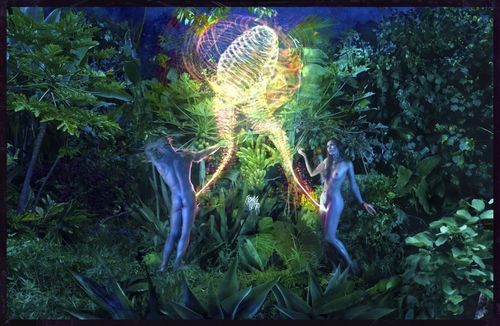
Adam and Eve, 2015. David LaChapelle MARUANI MERCIER GALLERY
From these rigid perspectives, Eve is one-dimensional: inherently wicked and an afterthought to Adam. Yet across popular culture and the history of art, Eve appears as a paradox. She is guileful and naive, earth mother and fatal seductress; she is the problem of man, his downfall, his eternal scapegoat.
Such depictions have structured our ideas of beauty, gender, and morality. The oldest conceptions of Eve play out again and again in all reaches of contemporary culture. A judiciously placed apple in a woman’s hand in art, advertising, or film can immediately invoke Eve’s devious sexuality, and still other references abound. The Handmaid’s Tale (2017–ongoing), adapted by Hulu from Margaret Atwood’s dystopian novel, features a young, religious character named Eden, who is expected to help repopulate the country. By the same token, in Pixar’s animated children’s movie WALL-E (2008), the title robot meets a fellow android who has come to bring new human life to Earth. Her name? EVE.
Forbidden fruit
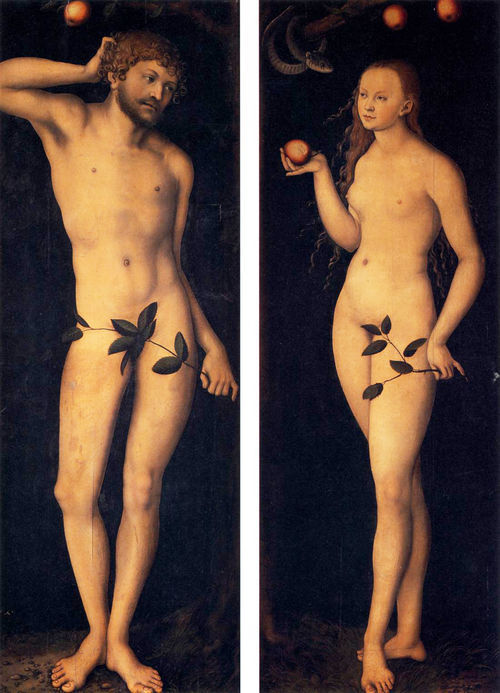
Lucas Cranach the Elder, Adam and Eve, 1528. Courtesy of the Uffizi Gallery.
Though never explicitly named in the Bible, the apple has become the de facto “forbidden fruit”—powerful nomenclature for that which is fatally desirable, and therefore all the more tempting and worthy of moral rule-breaking. The apple’s shiny red skin and juicy interior make it an apt stand-in for sex, and the seductive way in which Eve is often depicted eating it only reinforces its libidinal connotations. Genesis records that after Eve takes a bite of the fruit, she simply “gave some to her husband and he ate.” St. Jerome, however, used the Latin word seducta to describe Eve’s transgression.
During the Northern Renaissance, German artist Lucas Cranach the Elder perfected the bewitching female nude. In his Adam and Eve diptych from 1528, the couple faces one another beneath the Tree of Knowledge, little red apples bobbing tantalizingly above their heads. A self-possessed Eve holds one perfect fruit out to her husband, who scratches behind his ear in apparent befuddlement. In Cranach’s depiction, it’s not the serpent whispering in Eve’s ear or even the apple that is dangerous, but the perfectly beautiful and alluring woman who will be his pleasure—and his downfall.
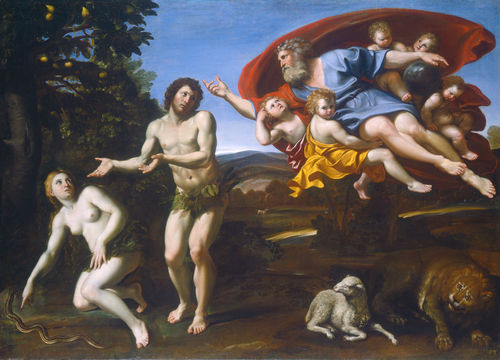
Domenichino, The Rebuke of Adam and Eve, 1626. Courtesy of the National Gallery of Art.
Men are often shown as helpless in the face of this female threat. In Domenichino’s 1626 painting, The Rebuke of Adam and Eve, God and his coterie of cherubim float down from heaven to reproach Adam. The first man throws up his hands in what looks like confusion or exasperation, diverting the entirety of the blame to his wife.
The image of Eve as sexual temptress has remained frighteningly constant, even in products and programs that purport to challenge ingrained sexist tropes. In the early aughts, for example, the soapy comedy-drama Desperate Housewives was lauded for casting five middle-aged women in the lead roles. The intended audience for the salacious TV show was presumably women, yet the impossibly fit, botoxed, and high-heeled characters seemed designed to appeal to men.
The apple’s shiny red skin and juicy interior make it an apt stand-in for sex, and the seductive way in which Eve is often depicted eating it only reinforces its libidinal connotations.
Red apples played prominently in promotional materials for the show. In the title sequence, an animated version of Cranach’s Adam is crushed by a giant falling apple as a blasé Eve looks on. In posters ahead of season five, the topless cast smiles coyly from behind a row of apples and the tagline “Even Juicier.”
So should one eat the apple or abstain? Designer Donna Karan exploited this ambiguity for her long-running DKNY scent Red Delicious. In the ads, a pouty model has just bitten into a green apple (how subversive), and the perfume packaging itself is shaped like the fruit. Sin is no longer the province of Eve alone: The “new temptation in fragrance” was marketed to both women and men.
Once in a while, the story of a woman with an apple doesn’t explicitly end with damnation or sex. In Disney’s Aladdin, the apples Princess Jasmine steals for a young, hungry boy lead to her meeting the titular male hero. They go on to have fabulous adventures together, but it’s Aladdin who reveals the world to Jasmine, and not the other way around. Sometimes apples—potent transmitters of dangerous information—are exchanged between women. In the 19th-century fairy tale that would later become a Disney classic, a witch proffers the poison apple that puts Snow White to sleep.
Snake charmer
In the book of Genesis, the tempting creature is explicitly referred to as “he” and is described only as a serpent. Yet Eve’s casting as an evil temptress gave rise to the belief that the duplicitous snake was female, too. In art, it was often depicted with a womanly upper body and a reptilian lower half. If wickedness is associated with femininity even before Eve gives Adam the Forbidden Fruit, which came first, woman or sin?
Michelangelo’s Sistine Chapel version of the Fall sees his muscular Adam and Eve joined by an equally hulking snake-woman wrapped around the tree. Her right arm grasps the trunk for support as she stretches out to meet Eve’s upraised hand. Both Eve and the serpent use their left, or “sinister,” hands, further signaling their deviousness.
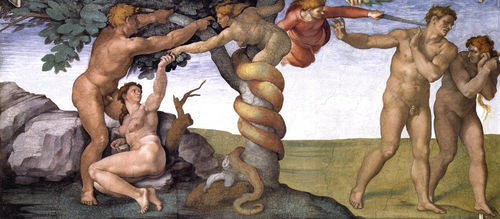
Michelangelo, The Fall of Man, 1512. Image via Wikimedia Commons.
Michelangelo was merely following a popular convention of his time. During the Renaissance, snake-women appear in Hugo van der Goes’s The Fall of Man and The Lamentation (ca. 1470–75); a terracotta sculpture of Adam and Eve by the workshop of Giovanni della Robbia (ca. 1515), which took inspiration from a famous Albrecht Dürer engraving; and the stone facade of Notre Dame. A blonde-headed serpent woman in Masolino’s Temptation of Adam and Eve (ca. 1425), a fresco in Florence’s Santa Maria del Carmine, is frighteningly funny: She snakes along the Tree of Knowledge with her comically tiny head popping out of the end of her skinny green body.
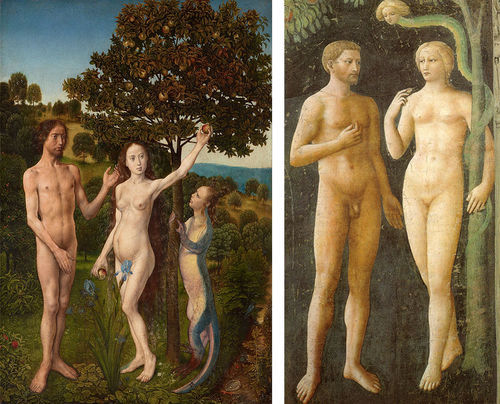
Left: Hugo van der Goes, The Fall of Man and The Lamentation, 1470–75. Courtesy of the Kunsthistorisches Museum. Right: Masolino da Panicale, Temptation of Adam and Eve, ca. 1425. Courtesy of Cappella Brancacci.
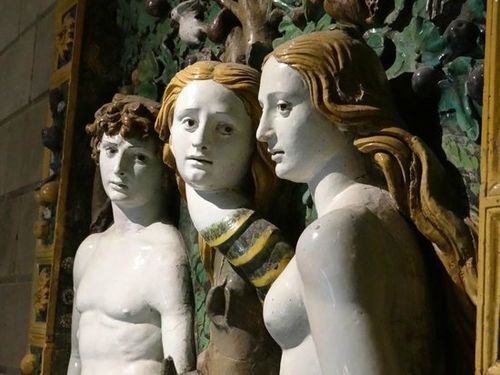
Giovanni della Robbia, Adam and Eve, ca. 1515.
Even before the Bible story, snakes were associated with women in cultures around the globe. The hostility that is created between them in the Bible may have been a way to separate the nascent Jewish community from pagan traditions that had a snake as a powerful female goddess. The Canaanite cult of Baal-Asherah heavily influenced the newly formed Israelite nation. In the predominantly female cult, Baal appeared in the form of a serpent with his wife, Asherah, at his side. When the Israelites entered Canaan, pagan religions were demonized in lieu of monotheism.
In this light, the story of Adam and Eve has political undertones. The biblical narrator may have already witnessed an established association between the serpent and the woman in neighboring tribes. When God punishes them, a wedge is driven between the serpent and the woman, cursing everlasting “enmity” between them and their offspring. The story successfully alienates the woman from her longtime ally.
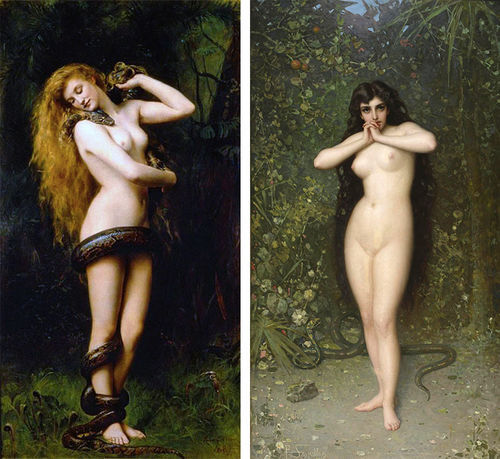
Left: John Collier, Lilith, 1887. Image via Wikimedia Commons. Right: Pantaleon Szyndler, Eve (Temptation), 1889. Courtesy of the National Museum in Warsaw.
They are indeed powerful together. Who can forget the 2001 MTV Video Music Awards, when Britney Spears walked onstage with an albino python draped across her neck? Dressed as an exotic snake charmer and scantily clad in artfully tattered rags and glitter, Spears fully assumed her onstage persona as an outlet to embrace her newfound sexual freedom. The conflation of the pop star with a sexual goddess transpired before millions of girls and women in the public forum of television. With that scene from Genesis, snakes and women received their eternal reputation of immorality. The snake became an erotic symbol as “the bad girl” gained sex appeal.
The fall of (wo)man
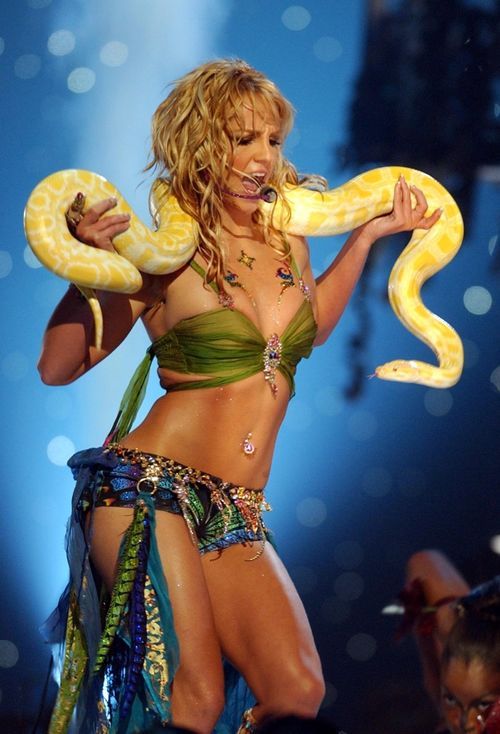
Britney Spears performs at the 2001 MTV Video Music Awards. Photo by Kevin Mazur/WireImage.
Spears’s performance resonates with an artwork made over a century earlier by Pre-Raphaelite painter John Collier. With her perfect, naked body and long blonde hair, the woman in the 1887 painting who nuzzles the head of the giant snake sensually coiled around her looks like Eve. But in fact, it’s her alter ego, the legendary femme fatale, Lilith.
Fed-up women looking for a new matriarchal origin story have taken in Eve beneath their own gaze. They have embraced the qualities—independence, curiosity, sexuality—that once demonized her.
In Jewish literature, the enchantress Lilith is described as Adam’s first wife, before Eve. Lilith was man’s equal but was devilish in her sexuality. According to legend, she felt repressed by Adam’s side, and she eventually leaves him to cohabit with demons in deep waters. In folklore and pop culture, she has come to be known as the mother of demons and vampires, eater of babies, husband of Satan—in short, a dangerous, sexually liberated woman.
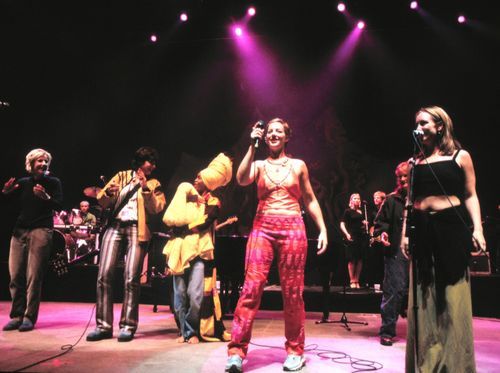
Lilith Fair, 1998, Mountain View California. Image by Tim Mosenfelder / ImageDirect via Getty Images.
Finally, in our modern era, fed-up women looking for a new matriarchal origin story have taken in Eve, and her alter ego Lilith, beneath their own gaze. They have embraced the qualities—independence, curiosity, sexuality—that once demonized her.
Kiki Smith’s take on Lilith (1994) is a powerful and disturbing sculpture—a black-bronze horror movie demon, nude and crouched in a spider-like position high up on the wall. The glass grey eyes startle any viewer. An unlikeable woman, who is not sexually available, nor coy, is a forcefully unusual statement.
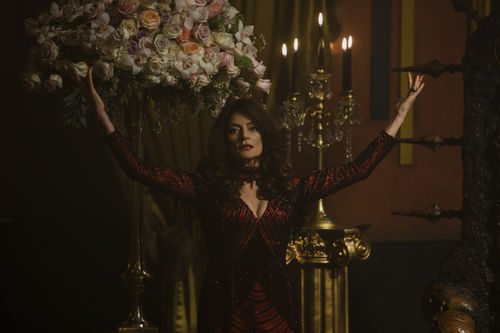
Madam Satan from The Chilling Adventures of Sabrina. Photo by Diyah Pera. Courtesy of Netflix.
Lilith appears in many guises in TV and movies: the progenitor of the vampire race in True Blood (2008–14); Madam Satan on The Chilling Adventures of Sabrina (2018–ongoing); the frigid, hated ex-wife of sitcom icon Frasier. The sci-fi movie The Fifth Element (1997) turns the concept of Lilith on its head by having the main character Leeloo—a variation on Lilith—save humanity instead of devouring it. Her name has also been invoked as a statement of feminist independence: The Lilith Fair of the late 1990s adopted the legendary woman’s name for a music festival that showcased only female artists or woman-led bands.
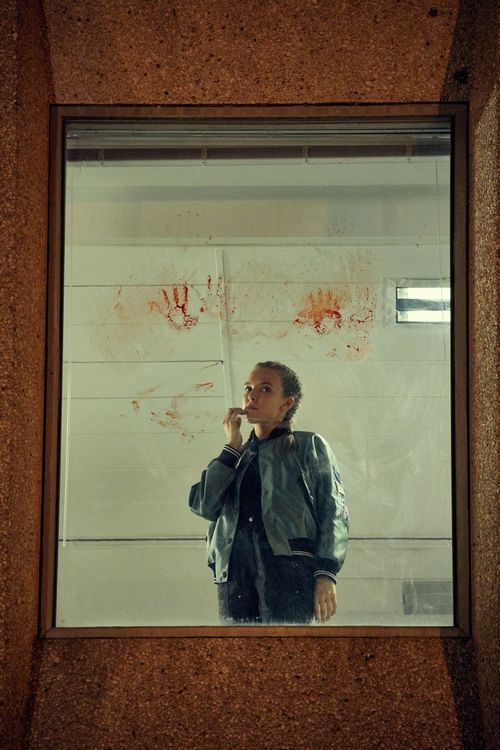
Villanelle from Killing Eve. Courtesy of the BBC.
One recent TV show has gone above and beyond in complicating our understanding of Eve, and women. The BBC series Killing Eve (2018–ongoing), which follows an M15 agent, played by Sandra Oh, as she tracks down a psychopathic female assassin portrayed by Jodie Comer. Guess who is Eve? It’s not the assassin. The delight of the show is seeing the intense connection unfold between the so-called good and bad guys. Who is on which side becomes impossible to understand—both women contain multitudes. The sexual drama lies between the killer, Villanelle, and Eve—not a man. Though the title of the show probably refers literally to Villanelle’s overarching plans, it’s also a fitting metaphor for the destruction of the story of Eve itself—and all the misery, unfair expectations, and misrepresentation that have come along with it.
from Artsy News
4 notes
·
View notes